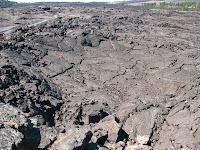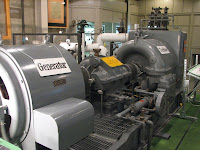Before I begin I want to mention that when looking at the blog, if you double click on the pictures a larger version will open up, but you all probably knew that already. :)
Sunday, Aug 16 we drove from Fruitland to Arco, ID. On the way we passed the Craters of the Moon National Monument and looked forward to visiting on Monday. We stayed at Mountain View RV Park, Nice people and a nice park. Their sign says it all. The free “Campers Breakfast” includes all the coffee you can drink, two eggs cooked as you order them and two hugh pancakes that fill the plate. Jackie and I had the full breakfast the first day but only ordered one pancake after that.
With full stomachs we set off for Craters of the Moon. About a mile before the entrance we came upon one of those information stops.
This area is known as the Great Rift. About 15,000 years ago lava welled up from the rift to produce the vast area we see covered with lava today. The eruptions started and stopped several times, with the latest one occurring about 2000 years ago. There is a camp ground in the park. The site are primitive, no electricity, a central source for water and a dump station. There is a restroom with electricity but no showers. The sites are on lava. I read on article that called it “desolate looking surroundings”.
On this loop trail there are there are examples of different lava flow characteristics, Squeeze Ups and Pressure Ridges.
Also there is the difference in lava flows. There is the smooth or ropy “Pahoehoe” which comes from hot fluid lava and the cooler lave that forms rough jagged rocks of lava know as “aa” (Ah Ah)
There were two that we climbed up to look at. One actually had snow inside the crater. The nights get cold in the high dessert (40’s at night) but hot during the day, being in a crater shields the snow from the sun.
There are features known as “collapses” “caves” and “tunnels” . The lava cools on the surface but still is very hot and flowing beneath it’s frozen surface. Frozen is a relative term since flowing lava can in the range of 1300 to 2400 deg. F. So, if the surface cools and solidifies while underneath a river of lava is running, then the flow stops, a tunnel is left. If conditions are right the roof of the tunnel collapses and a "Collapse" is formed. If a pocket is left and part of the roof collapses a cave is formed.
At first I had visions of walking through the tunnel but as I went down the steps the lava rocks were much larger than I anticipated. Dressed in sneakers, shorts and a t-shirt, I was not equipped to try it.
There are more pictures at: http://jackbarbic.shutterfly.com/4143
When we went into the town of Arco we saw a sign that made me wonder about the town.
It turns out that about 18 miles south east of the town on Rt. 26 is where the first Experimental Breeder Reactor (EBR-1) was built. After WWII it seemed that there would not be enough uranium to allow all the proposed uses for it to become reality. Enrico Fermi was the man that developed the idea of the breeder reactor. The breeder reactor uses Uranium 235 as a fuel, surrounded by a “breeding blanket of Uranium 238. The following photo’s explain.
8565
EBR-1 was built is a sparsely inhabited location. The next photo is taken from a rest stop on RT 26 about a mile from the road that leads to the reactor. EBR-1 is the small dark spot at the left side of the butte. There are a series of information signs about the area and inside EBR-1 there was a schematic of the Idaho National Laboratory complex
There guided and self guided tours. The stops are numbered and easy to follow if you want to tour on your own. I asked the guide about the complex as I had started down a wrong road until I saw a guard post and a sign that said “Authorized Personnel Only” and a guarded gate just beyond the sign.
Among other things, I was told that there currently about 8000 people working there. I asked about where they would live since Arco is way too small and I hadn’t seen anything else that looked like civilization. They live in towns like Idaho Falls and other towns that lie to the south and east of the facility. She said that her commute time is about an hour each way.
I took pictures inside the facility and they are at: http://jackbarbic.shutterfly.com/4386
Heat from the reactor generated steam that powered a turbine attached to an electric generator. EBR-1 first generated electricity in 1951. The names of those involved were listed an a black board.
Another project that peaked my interest was the Atomic Plane. In my past life I worked for Pratt & Whitney, a manufacturer of jet engines. In 1976 I transferred to their facility in Florida and in talking to fellow workers I was told about an Atomic Engine. One time I saw a strange engine in the shop area and was told that was it.
The idea was, rather than burn fuel to generate heat in a jet engine, the heat would be generated by an atomic powered “heat generator”. Outside the EBR-1 building is another area where there were two of the Heat Transfer Experimental Reactors (HTER). The picture below shows HTER-3 which powered two J-47 engines.
There are some guys from Pratt & Whitney on the distribution. Can any of you confirm that the picture below is the P&W atomic engine? I think it is but it’s tough to recall what I saw so long ago in Experimental Assembly.
The program was cancelled by President Kennedy. Conventional bomber and missile technology advanced to the point where the Atomic Bomber would be obsolete before it was built. So was it worth it? The answered is below.
As I drove out I stopped to take this picture and marvel at the work that has gone on and continues at the Idaho National Laboratory,,,,,,,, in the desert, in the middle of no where.
There are general interest pictures of some sites in Arco including a memorial to the nuclear powered submarine USS Hawkbill in the album.
We have now moved to Victor ID, just west of the Tetons. I want to send this out and haven't done all the editing I usually do on the albums. I hope they are not too haphazard for the viewers.


















































No comments:
Post a Comment